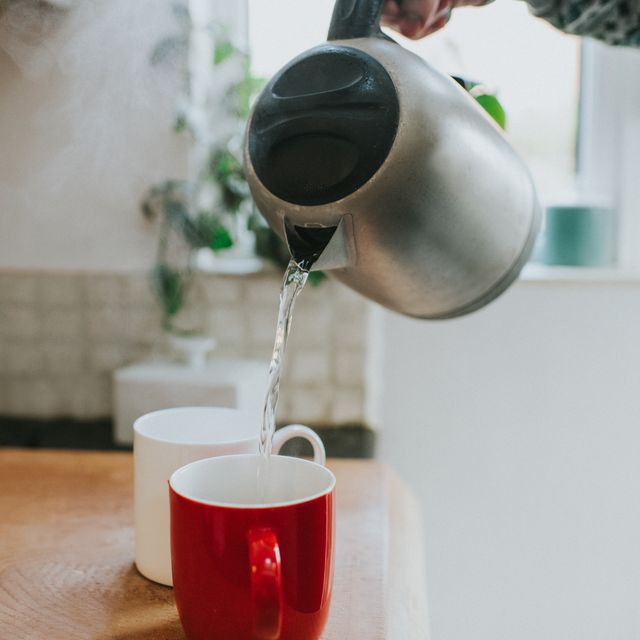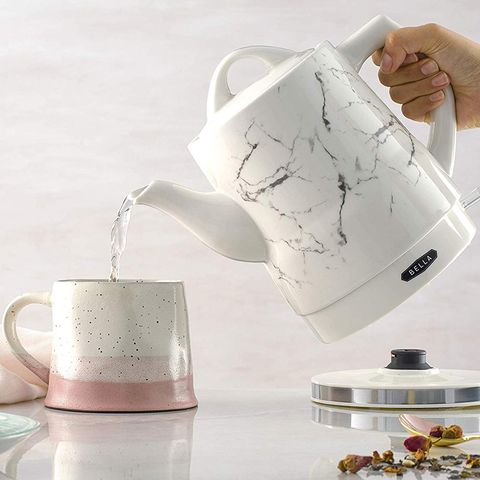Catherine Falls CommercialGetty Images
A great electric kettle lets you prepare a cup of hot, healthy tea or quickly boil water for an iced tea maker when you want a cool drink instead. Electric kettles heat quickly and efficiently, saving you from turning on a stove, and cooks have figured out that it’s a fast way to boil water when you’re making a quick pasta dish, too.
In general, electric kettles are very low-maintenance. But one thing to watch for is mineral buildup — namely calcium and magnesium from your local water supply — settling on the inside. This buildup can affect how long the kettle takes to boil water. Removing this mineral buildup is known as “descaling,” and how often you descale your electric kettle will depend on how “hard” your water is. Hard water contains more mineral deposits, so you’ll need to descale more often. In general, you may want to clean it once a month, or per the manufacturer’s directions. If your kettle is glass and you can easily see the bottom, you can simply eyeball when buildup occurs and clean accordingly.
Some manufacturers sell descaling solutions specifically for this process. The best DIY way to do it, however, is with distilled white vinegar. You can also use lemon juice, citric acid or baking soda — it’s the acid that does the trick. We’ll walk you through the three main DIY methods for descaling a kettle and provide some tips for cleaning the outside of your electric kettle as well.
Method 1: With Vinegar
This is a thorough way to descale the inside of your electric kettle as recommended by the Good Housekeeping Institute Kitchen Appliances and Innovation Lab. If you’ve ever cleaned a Keurig coffee maker, it should look familiar.
- Combine one part white distilled vinegar and three parts fresh water in the kettle. Our experience has shown that you don’t need to fill the kettle more than a third full. For a 1-liter electric kettle, use 1/4 cup of vinegar and 3/4 cup of water. If your electric kettle is larger, try 1/2 cup vinegar and 1 1/2 cups water.
- Bring the water and vinegar to a boil, turn the kettle off then let it sit for 20 minutes.
- Rinse it out several times with fresh water to flush away the buildup. If the buildup was heavy, you can use a soft sponge or cloth to wipe the inside of the kettle as well.
- To ensure any lingering vinegar taste is gone, you can optionally refill the kettle with water only, boil and discard.
Method 2: With Lemon Juice or Citric Acid
The acid in lemon juice can also descale an electric kettle, and since tea and lemon pair naturally you won’t have to worry about any unappetizing lingering tastes. Alternatively, you can use citric acid powder, which dissolves in water and then breaks down gunk in the same way as lemon juice. Citric acid powder is often sold alongside spices in grocery stores and is used in canning and preserving. It’s also a natural preservative listed on plenty of food labels. For this method:
- Combine 1 tablespoon of lemon juice or 1 tablespoon of citric acid with enough water to cover the bottom of your kettle.
- Bring the liquid to a boil, turn off the kettle and let it sit for about 20 minutes. Dump out the mixture and rinse the kettle thoroughly with fresh water.
Method 3: With Baking Soda
Baking soda is a tried-and-true cleaner and works well for descaling light deposits in the bottom of your electric kettle. Use it this way:
- Scoop 1 to 2 teaspoons of baking soda into the kettle, then add water to at least the halfway mark.
- Boil, turn the kettle off and let the mixture sit for 20 minutes.
- Rinse the kettle with water and wipe the bottom with a sponge or soft cloth. Rinse again to be sure you’re rid of all traces of baking soda.
Tips for Cleaning the Inside of an Electric Kettle
- If the buildup is especially bad or you’re cleaning for the first time in a year or more, you can let your cleaning solution — whether you’re using vinegar, lemon juice, citric acid or baking soda — sit overnight before you rinse.
- Cleaning methods are the same whether your electric kettle is made of glass, ceramic or stainless steel.
- If your electric kettle has a filter, most manufacturers recommend that you remove it and run it under water to clean it, then wipe it with a clean cloth.
- You don’t need to use dish soap inside a kettle. Most manufacturers only recommend an electric kettle for boiling water, so you shouldn’t have grease or food stains inside to worry about. Also, you shouldn’t use an abrasive brush inside, because you want to protect the heating element. Bottom line: Be gentle!
How to Clean the Outside of Your Electric Kettle
We suggest wiping down the outside every so often, and especially if your electric kettle gets splattered with grease or sauce during the course of cooking. Dip a cloth into a sudsy mix of dish soap and water, wring out so that it’s just damp and not soaking wet and wipe the kettle clean. Repeat the process with clean water to rinse the soal. Do not place your kettle under running water. You should not immerse it or put it in the dishwasher either. This could damage the electronics.
This content is created and maintained by a third party, and imported onto this page to help users provide their email addresses. You may be able to find more information about this and similar content at piano.io


